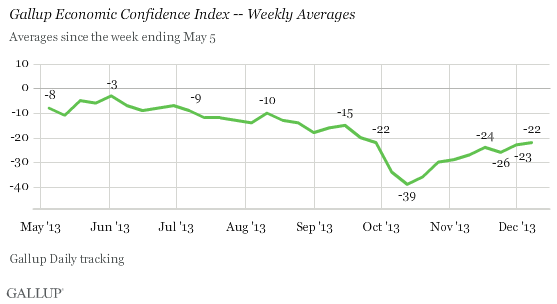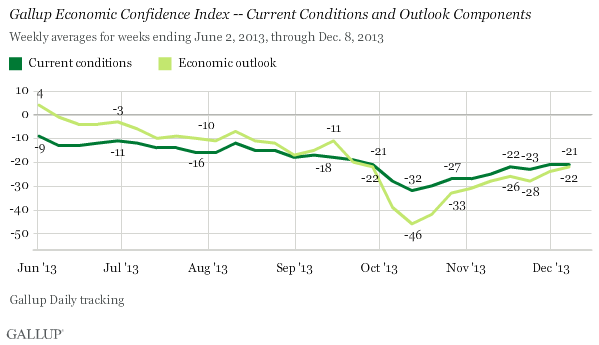WASHINGTON, D.C. -- Americans' confidence in the economy is still slowly recovering from its government shutdown-induced plunge. Gallup's Economic Confidence Index averaged -22 last week, significantly improved from -39 during the second week of the federal government shutdown in October but below the -15 found in mid-September. Still, confidence has a long way to go to bounce back to its peak of -3 reached in late May and early June.

In the first 2 1/2 weeks after the government shutdown ended, confidence improved 10 full points, from -39 to -29. Since then, the index has improved more gradually, moving up a total of seven points over the last five weeks.
The index last week was similar to the -23 registered the week before, but this masks a drop in confidence at the beginning of the week and a gain toward the end. Gallup's three-day rolling averages show that most of the improvement happened after the Bureau of Labor Statistics released a positive labor report on Friday, showing the unemployment rate in November dropping to its lowest level in five years. The index was -25 for Monday-Wednesday interviewing and -19 for Friday-Sunday interviewing.
From a broader perspective, the Gallup Economic Confidence Index -- which is based on Americans' assessments of current U.S. economic conditions and their perceptions of whether the economy is getting better or worse -- remains in negative territory. But despite drops in confidence this year after the fiscal cliff deal, automatic budget sequestration cuts, and the recent government shutdown, the yearly average is on pace to be the highest since Gallup began tracking economic confidence daily in 2008.
Perceptions of Future Conditions Have Only Partially Recovered
The outlook component fell much further than the current conditions component did during the shutdown and is still far off from its mid-September level. Americans' net economic outlook score rose to -22 last week from -46 in mid-October, but remains well below the -11 measured in mid-September. The current score represents 37% who said the economy is getting better and 59% who said it is getting worse.
On the other hand, Americans' assessments of the current state of the U.S. economy have almost completely rebounded. The net current conditions score last week was -21, up from -32 during mid-October and close to the -18 found in mid-September. The current score represents 17% of Americans who say the economy is "excellent" or "good," while 38% say it is "poor."

Implications
As Americans' confidence in the economy continues to recover from its government shutdown-fueled slide, budget negotiations are once again heating up in Washington. Congressional negotiators are aiming to have a deal to reduce automatic spending cuts and fund the federal government by the Jan. 15 deadline. If federal lawmakers reach a fiscal deal without partisan wrangling, it could boost consumer confidence.
Additionally, if the positive momentum in the labor market continues, and stock prices and home values continue to rise, it may be enough for Americans to be, on balance, more positive than negative about the economy next year.
Gallup.com reports results from these indexes in daily, weekly, and monthly averages and in Gallup.com stories. Complete trend data are always available to view and export in the following charts:
Daily: Employment, Economic Confidence, Job Creation, Consumer Spending
Weekly: Employment, Economic Confidence, Job Creation, Consumer Spending
Read more about Gallup's economic measures.
View our economic release schedule.
Survey Methods
Results for this Gallup poll are based on telephone interviews conducted Dec. 2-8, 2013, on the Gallup Daily tracking survey, with a random sample of 3,038 adults, aged 18 and older, living in all 50 U.S. states and the District of Columbia.
For results based on the total sample of national adults, the margin of sampling error is ±3 percentage points at the 95% confidence level.
Interviews are conducted with respondents on landline telephones and cellular phones, with interviews conducted in Spanish for respondents who are primarily Spanish-speaking. Each sample of national adults includes a minimum quota of 50% cellphone respondents and 50% landline respondents, with additional minimum quotas by region. Landline and cell telephone numbers are selected using random-digit-dial methods. Landline respondents are chosen at random within each household on the basis of which member had the most recent birthday.
Samples are weighted to correct for unequal selection probability, nonresponse, and double coverage of landline and cell users in the two sampling frames. They are also weighted to match the national demographics of gender, age, race, Hispanic ethnicity, education, region, population density, and phone status (cellphone only/landline only/both, and cellphone mostly). Demographic weighting targets are based on the March 2012 Current Population Survey figures for the aged 18 and older U.S. population. Phone status targets are based on the July-December 2011 National Health Interview Survey. Population density targets are based on the 2010 census. All reported margins of sampling error include the computed design effects for weighting.
In addition to sampling error, question wording and practical difficulties in conducting surveys can introduce error or bias into the findings of public opinion polls.
For more details on Gallup's polling methodology, visit www.gallup.com.
